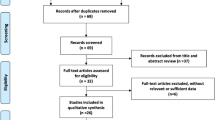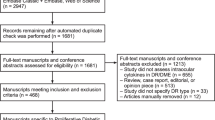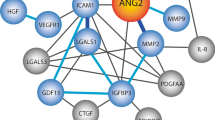Abstract
Aim
To ascertain whether vitreous and plasma levels of vascular endothelial growth factor (VEGF), interleukin-6 (IL-6) and fundus findings could predict the outcome of vitreous surgery in patients with proliferative diabetic retinopathy (PDR).
Methods
Vitreous fluid samples were obtained during vitreoretinal surgery from 73 consecutive eyes with PDR. The levels of VEGF and IL-6 in vitreous fluid and plasma were determined by enzyme-linked immunosorbent assay. Patients were prospectively followed for 6 months and the postoperative outcome was analysed by logistic regression analysis.
Results
No improvement and/or progression of PDR occurred in 23 (32%) of the 73 eyes (progression group). The vitreous levels of VEGF and IL-6 were significantly higher in eyes from the progression group than in eyes with regression of PDR (regression group) (P=0.0032 and 0.0088, respectively). Multivariate logistic regression analysis showed that higher vitreous levels of VEGF were associated with the progression of PDR after vitreous surgery (odds ratio 2.72, P=0.0003).
Conclusions
High vitreous levels of VEGF identified as a significant risk factor for the outcome of vitreous surgery in patients with PDR. A model was developed to predict the probability of PDR progression and measurement of the vitreous level of VEGF may be useful for predicting the outcome of surgery.
Similar content being viewed by others
Log in or create a free account to read this content
Gain free access to this article, as well as selected content from this journal and more on nature.com
or
References
Cai J, Boulton M . The pathogenesis of diabetic retinopathy: old concepts and new questions. Eye 2002; 16: 242–260.
Aiello LP, Avery RL, Arrigg PG, Keyt BA, Jampel HD, Shah ST et al. Vascular endothelial growth factor in ocular fluid of patients with diabetic retinopathy and other retinal disorders. N Engl J Med 1994; 331: 1480–1487.
Funatsu H, Yamashita H, Nakanishi Y, Hori S . Angiotensin II and vascular endothelial growth factor in the vitreous fluid of patients with proliferative diabetic retinopathy. Br J Ophthalmol 2002; 86: 311–315.
Adamis AP . Is diabetic retinopathy an inflammatory disease? Br J Ophthalmol 2002; 86: 363–365.
Hirano T, Akira S, Taga T, Kishimoto T . Biological and clinical aspects of interleukin-6. Immunol Today 1990; 11: 443–449.
Ongkosuwito JV, Feron EJ, van Doornik CE, Van der Lelij A, Hoyng CB, La Heiji EC et al. Analysis of immunoregulatory cytokines in ocular fluid samples from patients with uveitis. Invest Ophthalmol Vis Sci 1998; 39: 2659–2665.
Kauffmann DJ, van Meurs JC, Mertens DA, Peperkamp E, Master C, Gerritsen ME . Cytokines in vitreous humor: interleukin-6 is elevated in proliferative vitreoretinopathy. Invest Ophthalmol Vis Sci 1994; 35: 900–906.
Yan SF, Tritto I, Pinsky D, Liao H, Huang J, Fuller G et al. Induction of inerleukin-6 (IL-6) by hypoxia in vascular cells. Central role of the binding site for nuclear factor-IL-6. J Biol Chem 1995; 270: 11463–11471.
Cohen T, Nahari D, Cerem LW, Neufeld G, Levi BZ . Interleukin 6 induces the expression of vascular endothelial growth factor. J Biol Chem 1996; 271: 736–741.
Funatsu H, Yamashita H, Shimizu E, Kojima R, Hori S . Relationship between vascular endothelial growth factor and interleukin-6 in diabetic retinopathy. Retina 2001; 21: 469–477.
Early Treatment Diabetic Retinopathy Study Research Group. Grading diabetic retinopathy from stereoscopic color fundus photographs. An extension of the modified Airlie House classification. ETDRS Report Number 10. Ophthalmology 1991; 98: 786–806.
Early Treatment Diabetic Retinopathy Study Research Group. Fundus photographic risk factors for progression of diabetic retinopathy. ETDRS Report Number 12. Ophthalmology 1991; 98: 823–833.
SAS [computer manual]. Version 6.12. Cary, NC: SAS Inc., 1997.
Aiello LP, Northrup JM, Keyt BA, Takagi H, Iwamoto MA . Hypoxic regulation of vascular endothelial growth factor in retinal cells. Arch Ophthalmol 1995; 113: 1538–1544.
Lutty GA, McLeod S, Merges C, Diggs A, Plouet J . Localization of vascular endothelial growth factor in human retina and choroid. Arch Ophthalmol 1996; 114: 971–977.
Acknowledgements
We thank Drs Shigehiko Kitano, Erika Shimizu, Kozue Ohara, Kaori Sekimoto, Yuichiro Nakanishi, Rie Takeda, Koji Makita, and Kensuke Haruyama for their assistance in collecting the vitreous and plasma samples and in performing ophthalmological examinations. We also thank Dr Yasuhiko Iwamoto and Dr Naoko Iwasaki for their assistance in performing the internal medical examinations. Finally, we would like to thank Katsunori Shimada (Department of Biostatistics, STATZ Institute, Co., Ltd.) for his assistance in conducting the statistical analyses. This study was supported by Health Science Research Grants (10060101, Drs Hori, Funatsu, and Yamashita) from the Japanese Ministry of Health, Labor and Welfare.
Author information
Authors and Affiliations
Corresponding author
Rights and permissions
About this article
Cite this article
Funatsu, H., Yamashita, H., Mimura, T. et al. Risk evaluation of outcome of vitreous surgery based on vitreous levels of cytokines. Eye 21, 377–382 (2007). https://doi.org/10.1038/sj.eye.6702213
Received:
Revised:
Accepted:
Published:
Issue date:
DOI: https://doi.org/10.1038/sj.eye.6702213
Keywords
This article is cited by
-
Effect of Adjunctive Intravitreal Conbercept Injection at the End of 25G Vitrectomy on Severe Proliferative Diabetic Retinopathy: 6-Month Outcomes of a Randomised Controlled Trial
Ophthalmology and Therapy (2023)
-
Changes in aqueous and vitreous inflammatory cytokine levels in proliferative diabetic retinopathy: a systematic review and meta-analysis
Eye (2022)
-
The effect of adjunctive intravitreal conbercept at the end of diabetic vitrectomy for the prevention of post-vitrectomy hemorrhage in patients with severe proliferative diabetic retinopathy: a prospective, randomized pilot study
BMC Ophthalmology (2020)



